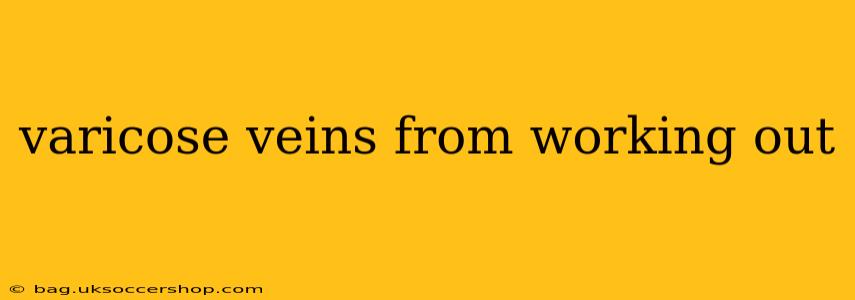Varicose veins, those unsightly, bulging veins often appearing on the legs, are a common concern. While many factors contribute to their development, a question frequently arises: can working out actually cause varicose veins? The answer isn't straightforward, and this comprehensive guide will explore the complex relationship between exercise and varicose vein formation.
Can Working Out Cause Varicose Veins?
The short answer is: not directly. Working out itself doesn't cause varicose veins. However, intense or prolonged physical activity, especially activities that put significant pressure on the legs, can exacerbate existing vein problems or potentially increase the risk in predisposed individuals. It's crucial to understand that varicose veins are primarily a result of weakened vein valves and increased pressure within the veins. Let's delve into the specifics.
What are Varicose Veins?
Varicose veins develop when the one-way valves inside your veins weaken or fail. This malfunction allows blood to flow backward, pooling in the veins and causing them to enlarge and become visible under the skin. Several factors contribute to this valve failure, including:
- Genetics: Family history is a significant risk factor.
- Age: Veins weaken naturally with age.
- Pregnancy: Hormonal changes and increased blood volume put extra strain on leg veins.
- Obesity: Excess weight adds pressure to the veins.
- Prolonged Standing or Sitting: Reduces blood flow and increases venous pressure.
How Does Exercise Impact Varicose Veins?
While exercise doesn't directly cause varicose veins, high-impact activities or prolonged periods of standing or sitting can worsen existing conditions. The increased pressure on leg veins during strenuous exercise can strain already weakened valves. This is particularly true for activities like:
- High-impact aerobics: Jumping jacks, running, and similar exercises put considerable stress on leg veins.
- Weightlifting: Lifting heavy weights can increase abdominal pressure, affecting venous return.
- Prolonged standing: Jobs or activities requiring extended periods of standing can significantly contribute to vein problems.
Conversely, regular moderate exercise, such as brisk walking or swimming, can actually benefit venous health by improving circulation and strengthening leg muscles. These muscles help pump blood back towards the heart, reducing pressure on the veins.
Are There Specific Workouts to Avoid if I Have Varicose Veins?
You don't need to avoid all forms of exercise if you have varicose veins. The key is to choose appropriate activities and modify your approach. High-impact activities should be performed in moderation, and prolonged periods of standing or sitting should be minimized. Consider incorporating these modifications:
- Low-impact exercises: Opt for activities like swimming, cycling, or water aerobics, which are gentler on the legs.
- Compression stockings: Wearing compression stockings during exercise can improve circulation and reduce venous pressure.
- Regular breaks: Take frequent breaks to move around and elevate your legs if you have a job or activity that requires prolonged standing or sitting.
Can Working Out Prevent Varicose Veins?
While exercise can't prevent varicose veins entirely, maintaining a healthy weight, improving circulation through regular moderate exercise, and avoiding prolonged periods of inactivity can contribute to overall venous health and potentially reduce your risk. A balanced lifestyle encompassing proper diet, exercise, and maintaining a healthy weight is beneficial for overall health, including venous health.
What are the Symptoms of Varicose Veins?
Recognizing the symptoms is crucial for early diagnosis and management. Common symptoms include:
- Visible bulging veins: The most noticeable sign.
- Leg pain and aching: Often worse after prolonged standing or sitting.
- Leg swelling: Fluid buildup can cause swelling in the ankles and feet.
- Leg cramps: Nighttime leg cramps are common.
- Skin discoloration: The skin over affected veins may appear discolored or darkened.
When Should I See a Doctor About Varicose Veins?
If you experience any of the symptoms mentioned above, consult a healthcare professional for proper diagnosis and treatment options. Early intervention can help prevent complications and improve your overall quality of life.
This information is for educational purposes only and does not constitute medical advice. Always consult with a healthcare professional for any health concerns or before making any decisions related to your health or treatment.
